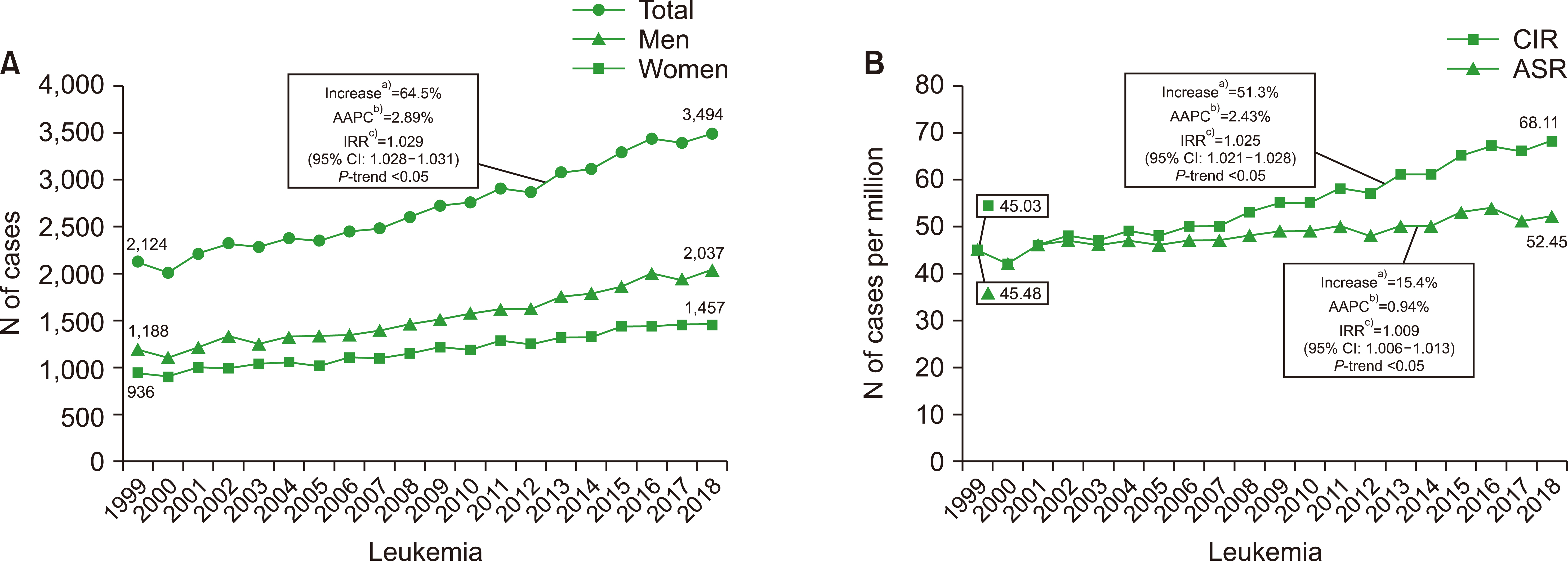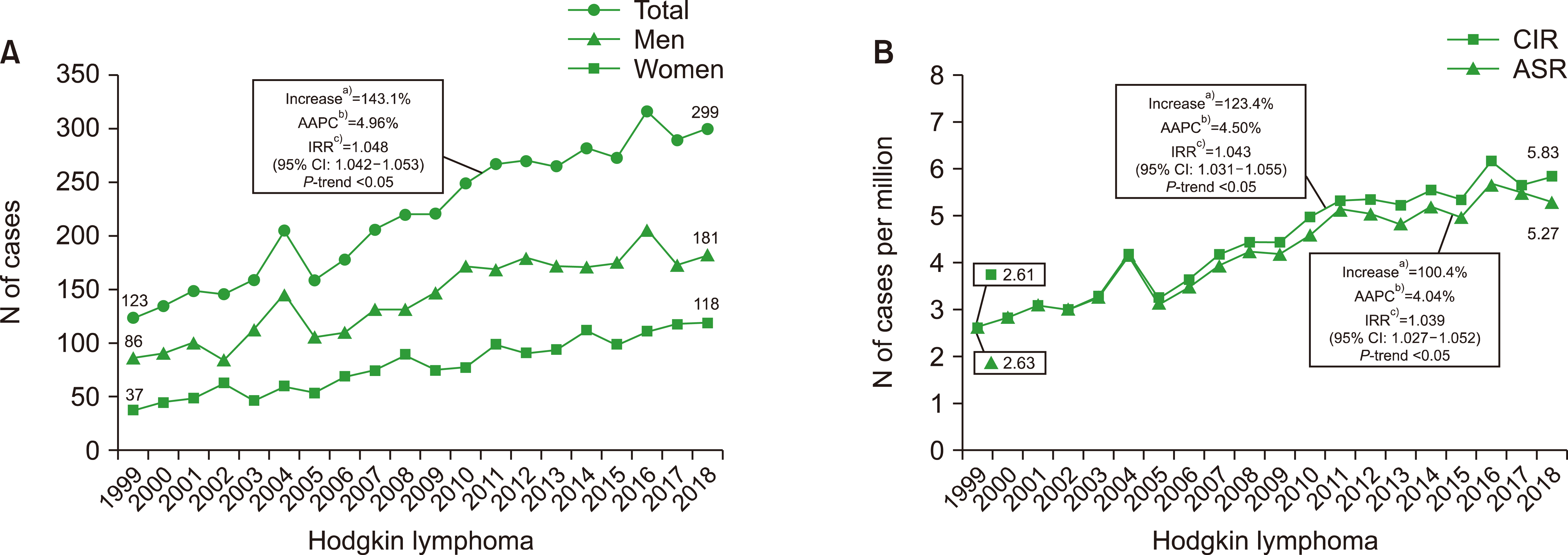Blood Res.
2021 Dec;56(4):301-314. 10.5045/br.2021.2021187.
Twenty-year incidence trend of hematologic malignancies in the Republic of Korea: 1999‒2018
- Affiliations
-
- 1Department of Occupational and Environmental Medicine, Chonnam National University Medical School and Chonnam National University Hwasun Hospital, Hwasun, Korea
- 2Gwangju Jeonnam Regional Cancer Center, Hwasun, Korea
- 3Jeollanamdo Public Health Policy Institute, Jeollanamdo Provincial Office, Muan, Korea
- 4Department of Laboratory Medicine, Chonnam National University Medical School and Chonnam National University Hwasun Hospital, Hwasun, Korea
- KMID: 2524090
- DOI: http://doi.org/10.5045/br.2021.2021187
Abstract
- Background
In this study, we presented the national cancer statistics on the incidence of hematologic malignancies in the Republic of Korea (ROK) over a period of 20 years, from 1999 to 2018.
Methods
We obtained data on the incidence of hematologic malignancies using the Korean Statistical Information Service (KOSIS). For each hematologic malignancy, the number of cases, crude incidence rate, and age-standardized incidence rate were calculated, and the statistical trends were confirmed by Poisson regression and Joinpoint regression analysis.
Results
All the investigated hematologic malignancies showed a statistically significant increase in incidence over 20 years. The 20-year trend of the age-standardized incidence rate was as follows: non-Hodgkin lymphoma [average annual percent change (AAPC)=2.26%, P-trend <0.05], leukemia (AAPC=0.94%, P-trend <0.05), myeloid leukemia (AAPC=1.44%, P-trend <0.05), multiple myeloma (AAPC=3.05%, P-trend <0.05), myeloproliferative disorders (AAPC=9.87%, P-trend <0.05), myelodysplastic syndrome (AAPC=7.59%, P-trend <0.05), malignant immunoproliferative diseases (AAPC=11.82%, P-trend <0.05), lymphoid leukemia (AAPC=2.21%, P-trend <0.05), and Hodgkin lymphoma (AAPC=4.04%, P <0.05).
Conclusion
It was confirmed that the incidence of hematologic malignancies has increased significantly in the ROK over the past 20 years. This study can be used as foundational data source for future studies. In addition, it can aid in the necessary actions of predicting future incidences and establishing future healthcare policies.
Keyword
Figure
Cited by 1 articles
-
Prognostic Value of Hematological Markers in Head and Neck Cancer Patients With a History of Hematological Malignancy
Jooin Bang, Oh-Hyeong Lee, Geun-Jeon Kim, Sang-Yeon Kim, Dong-Il Sun
Korean J Otorhinolaryngol-Head Neck Surg. 2023;66(10):678-685. doi: 10.3342/kjorl-hns.2023.00598.
Reference
-
1. Statistics Korea. 2020. Cause of death statistics in 2019. Statistics Korea;Daejeon, Korea: at http://kostat.go.kr/portal/eng/pressReleases/8/10/index.board. Accessed August 31, 2021.2. Hong S, Won YJ, Lee JJ, et al. 2021; Cancer statistics in Korea: incidence, mortality, survival, and prevalence in 2018. Cancer Res Treat. 53:301–5. DOI: 10.4143/crt.2021.291. PMID: 33735559. PMCID: PMC8053867.
Article3. Korean Statistical Information System (KOSIS). 2021. Statistical database. Statistics Korea;Daejeon, Korea: at https://kosis.kr/eng. Accessed August 31, 2021.4. Fritz A, Percy C, Jack A, et al. 2013. International classification of diseases for oncology. Third ed. World Health Organization;Geneva, Switzerland: at https://apps.who.int/iris/bitstream/handle/10665/96612/9789241548496_eng.pdf. Accessed August 31, 2021.5. National Cancer Center (NCC). 2021. Annual report of cancer statistics in Korea in 2018. NCC;Goyang-si, Korea: at https://ncc.re.kr/cancerStatsView.ncc?bbsnum=558&searchKey=total&searchValue=&pageNum=1. Accessed August 31, 2021.6. US National Cancer Institute (NCI). 2021. Joinpoint trend analysis software. US NCI;Bethesda, MD: at https://surveillance.cancer.gov/joinpoint. Accessed August 31, 2021.7. Qiu D, Katanoda K, Marugame T, Sobue T. 2009; A Joinpoint regression analysis of long-term trends in cancer mortality in Japan (1958-2004). Int J Cancer. 124:443–8. DOI: 10.1002/ijc.23911. PMID: 18844218.
Article8. Han Y, Kim YJ, Kim MJ, et al. 2020; Gradual increase in hematologic malignancy in Korea from 2005 to 2015 based on the National Health Insurance Service Data. Lab Med Online. 10:144–51. DOI: 10.3343/lmo.2020.10.2.144.
Article9. Park HJ, Park EH, Jung KW, et al. 2012; Statistics of hematologic malignancies in Korea: incidence, prevalence and survival rates from 1999 to 2008. Korean J Hematol. 47:28–38. DOI: 10.5045/kjh.2012.47.1.28. PMID: 22479275. PMCID: PMC3317467.
Article10. Park EH, Lee H, Won YJ, et al. 2015; Nationwide statistical analysis of myeloid malignancies in Korea: incidence and survival rate from 1999 to 2012. Blood Res. 50:204–17. DOI: 10.5045/br.2015.50.4.204. PMID: 26770948. PMCID: PMC4705046.
Article11. Lee H, Park HJ, Park EH, et al. 2018; Nationwide statistical analysis of lymphoid malignancies in Korea. Cancer Res Treat. 50:222–38. DOI: 10.4143/crt.2017.093. PMID: 28361523. PMCID: PMC5784621.
Article12. Keykhaei M, Masinaei M, Mohammadi E, et al. 2021; A global, regional, and national survey on burden and Quality of Care Index (QCI) of hematologic malignancies; global burden of disease systematic analysis 1990-2017. Exp Hematol Oncol. 10:11. DOI: 10.1186/s40164-021-00198-2. PMID: 33557940. PMCID: PMC7869509.
Article13. Dong Y, Shi O, Zeng Q, et al. 2020; Leukemia incidence trends at the global, regional, and national level between 1990 and 2017. Exp Hematol Oncol. 9:14. DOI: 10.1186/s40164-020-00170-6. PMID: 32577323. PMCID: PMC7304189.
Article14. Smith A, Howell D, Patmore R, Jack A, Roman E. 2011; Incidence of haematological malignancy by sub-type: a report from the Haematological Malignancy Research Network. Br J Cancer. 105:1684–92. DOI: 10.1038/bjc.2011.450. PMID: 22045184. PMCID: PMC3242607.
Article15. Li J, Smith A, Crouch S, Oliver S, Roman E. 2016; Estimating the prevalence of hematological malignancies and precursor conditions using data from Haematological Malignancy Research Network (HMRN). Cancer Causes Control. 27:1019–26. DOI: 10.1007/s10552-016-0780-z. PMID: 27351920. PMCID: PMC4958130.
Article16. Fitzmaurice C, Akinyemiju TF, et al. Global Burden of Disease Cancer Collaboration. 2018; Global, regional, and national cancer incidence, mortality, years of life lost, years lived with disability, and disability-adjusted life-years for 29 cancer groups, 1990 to 2016: a systematic analysis for the global burden of disease study. JAMA Oncol. 4:1553–68. DOI: 10.1200/JCO.2018.36.15_suppl.1568. PMID: 29860482. PMCID: PMC6248091.17. Sant M, Allemani C, Tereanu C, et al. 2010; Incidence of hematologic malignancies in Europe by morphologic subtype: results of the HAEMACARE project. Blood. 116:3724–34. DOI: 10.1182/blood-2010-05-282632. PMID: 20664057.
Article18. Bray F, Ferlay J, Soerjomataram I, Siegel RL, Torre LA, Jemal A. 2018; Global cancer statistics 2018: GLOBOCAN estimates of incidence and mortality worldwide for 36 cancers in 185 countries. CA Cancer J Clin. 68:394–424. DOI: 10.3322/caac.21492. PMID: 30207593.
Article19. Brown S, Castelli M, Hunter DJ, et al. 2014; How might healthcare systems influence speed of cancer diagnosis: a narrative review. Soc Sci Med. 116:56–63. DOI: 10.1016/j.socscimed.2014.06.030. PMID: 24980792. PMCID: PMC4124238.
Article20. Lee KH, Lee S, Park JH, et al. 2021; Risk of hematologic malignant neoplasms from abdominopelvic computed tomographic radiation in patients who underwent appendectomy. JAMA Surg. 156:343–51. DOI: 10.1001/jamasurg.2020.6357. PMID: 33471110. PMCID: PMC8047726.
Article21. Molenaar RJ, Sidana S, Radivoyevitch T, et al. 2018; Risk of hematologic malignancies after radioiodine treatment of well-differentiated thyroid cancer. J Clin Oncol. 36:1831–9. DOI: 10.1200/JCO.2017.75.0232. PMID: 29252123. PMCID: PMC8462524.
Article22. Albert JM. 2013; Radiation risk from CT: implications for cancer screening. AJR Am J Roentgenol. 201:W81–7. DOI: 10.2214/AJR.12.9226. PMID: 23789701.
Article23. Teepen JC, van Dijck JA. 2012; Impact of high electromagnetic field levels on childhood leukemia incidence. Int J Cancer. 131:769–78. DOI: 10.1002/ijc.27542. PMID: 22437882.
Article24. International Agency for Research on Cancer (IARC) Working Group on the Evaluation of Carcinogenic Risks to Humans. 2002. Non-ionizing radiation, part 1: static and extremely low-frequency (ELF) electric and magnetic fields. Vol. 80:IARC Press;Lyon, France: p. 1–395.25. Nkanga MSN, Longo-Mbenza B, Adeniyi OV, et al. 2017; Ageing, exposure to pollution, and interactions between climate change and local seasons as oxidant conditions predicting incident hematologic malignancy at KINSHASA University clinics, Democratic Republic of CONGO (DRC). BMC Cancer. 17:559. DOI: 10.1186/s12885-017-3547-3. PMID: 28835214. PMCID: PMC5569529.
Article26. Jephcote C, Brown D, Verbeek T, Mah A. 2020; A systematic review and meta-analysis of haematological malignancies in residents living near petrochemical facilities. Environ Health. 19:53. DOI: 10.1186/s12940-020-00582-1. PMID: 32430062. PMCID: PMC7236944.
Article27. Statistics Korea. 2021. Cause of death statistics in 2019. Statistics Korea;Daejeon, Korea: at http://kostat.go.kr/portal/eng/pressReleases/8/7/index.board. Accessed August 31, 2021.
- Full Text Links
- Actions
-
Cited
- CITED
-
- Close
- Share
- Similar articles
-
- Statistics of hematologic malignancies in Korea: incidence, prevalence and survival rates from 1999 to 2008
- Risk of Hematologic Malignancies in Patients with Inflammatory Bowel Disease: A Meta-Analysis of Cohort Studies
- Incidence and Types of Constitutional Chromosomal Abnormalities in Patients with Hematologic Malignancies
- Twenty-two-year incidence trend of urological cancers in the Republic of Korea: 1999–2020
- Secondary Malignancies in Multiple Myeloma in Korean Patients: A Nationwide Population-Based Study










